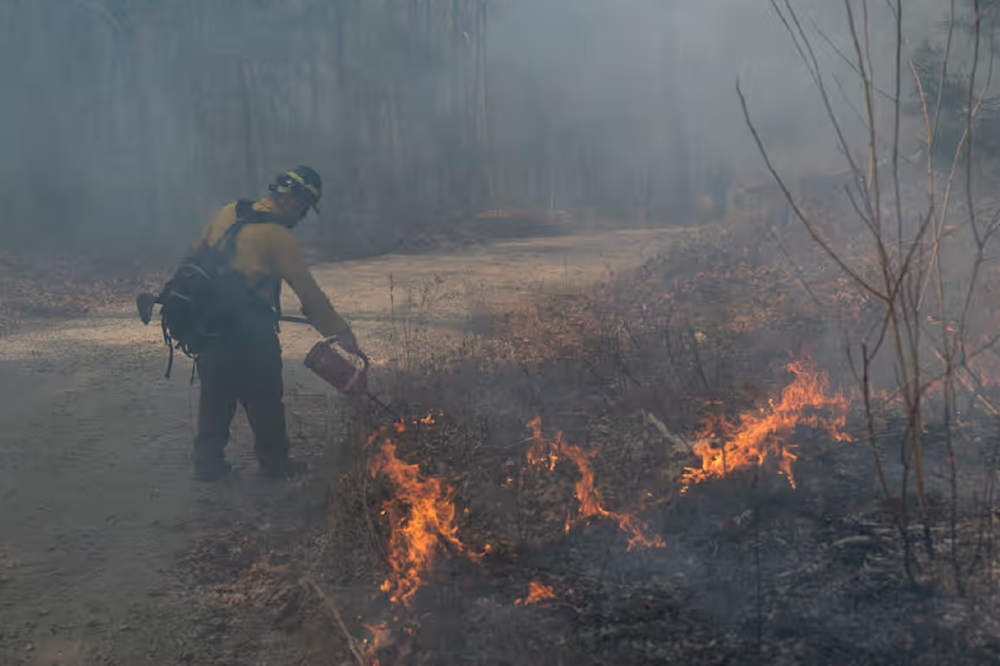Wildfires rage in North, South Carolina as firefighters deploy
Hundreds of residents have been compelled to evacuate their homes amid states of emergency and out-of-state rescuers fighting fires.
-
 A firefighter lights a protective backburn fire to control the Black Cove fire in Saluda, North Carolina, on 26 March 2025 (AP)
A firefighter lights a protective backburn fire to control the Black Cove fire in Saluda, North Carolina, on 26 March 2025 (AP)
Wildfires raged throughout North and South Carolina on Thursday, prompting state of emergency declarations and evacuations as firefighters from other regions of the United States were dispatched to assist in putting out the fires.
In North Carolina, progress was being made in confining two of the major wildfires burning in the mountains, but officials warned that fire danger persisted due to dry and windy weather.
The situation was worse in South Carolina, where two fires almost doubled in size on Wednesday. Hundreds of people have been urged to evacuate their homes in both states as a half-dozen big fires burn in the Blue Ridge mountains, pouring smoke into cities such as Greenville, which has a population of around 70,000.
On Wednesday, dry weather sparked multiple new fires in western North Carolina, prompting Governor Josh Stein to declare a state of emergency in 34 counties. At least nine active fires were reported in the region.
The North Carolina Department of Agriculture reported that the Black Cove Complex fire is currently the highest-priority wildfire in the US, with hundreds of firefighters battling the blaze.
Firefighting teams from Oregon have already sent dozens of personnel, with an additional 11 firefighters set to be deployed on Wednesday.
The fire is raging in an area devastated by Hurricane Helene in September, where millions of fallen trees are both fueling the flames and blocking firefighters' access to logging roads and pathways.
By Wednesday night, the North Carolina Forest Service reported that both the Black Cove and Deep Woods fires were over 10% contained, after several days with no containment progress.
The flames have destroyed about 6,400 acres (2,590 hectares) in total, although the extent of the burned area has remained practically unchanged since the previous day. Firefighters saved the majority of the structures, and only one firefighter was injured.
There is rain in the forecast for the weekend, but it is not the type of saturating downpour that may extinguish a fire on its own, according to National Weather Service meteorologist Ashley Rehnberg in Greer, SC.
"Hopefully that will at least calm things down briefly," Rehnberg remarked.
A silver lining could be that forecasts indicate there will be no particularly dangerous days when winds and dry weather reach potentially deadly levels, as they did in Los Angeles in January and Gatlinburg, Tennessee, in 2016.
Forestry authorities in North and South Carolina are already planning how to shuttle teams of firefighters into and out of the mountains during what could be a lengthy battle.
The fires in South Carolina were started by people, and authorities, from local fire chiefs to South Carolina's governor, are encouraging people to follow burn prohibitions in both states and cease lighting fires at campgrounds or burning waste.
South Carolina’s governor, Henry McMaster, urged the public to use "common sense," pointing to how people are in the woods and in their backyards, starting fires when the wind is blowing and everything is dry.
Wildfires in 2024 were a major contributor to a record-breaking surge in atmospheric carbon dioxide levels, catching scientists off guard, a recent report by The Guardian revealed in January. This alarming trend underscores humanity's increasing entanglement with a world beset by escalating extreme weather events.

 4 Min Read
4 Min Read








